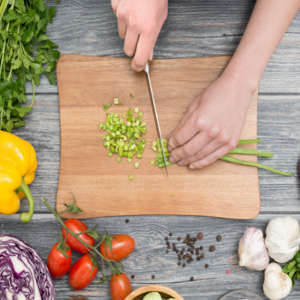 Anyone can cook, but it’s a skill that takes time to perfect. If you are new to the kitchen or need to hone your abilities, a great place to start is with your kitchen tools. After all, if you don’t know how to properly use utensils and appliances, you risk injury. Knives are one of the most common kitchen tools yet intimidating to many people.
Anyone can cook, but it’s a skill that takes time to perfect. If you are new to the kitchen or need to hone your abilities, a great place to start is with your kitchen tools. After all, if you don’t know how to properly use utensils and appliances, you risk injury. Knives are one of the most common kitchen tools yet intimidating to many people.
What should beginners know about knife use?
Different Types of Knives
There are many types of kitchen knives, but these are the most common ones you’re likely to find in a block for daily cooking needs:
- Chef’s Knife: This multi-purpose can cut through food items as soft as cheese, as hard as raw vegetables or thick as steak.
- Utility Knife: A mini chef’s knife, the utility knife cuts hard and soft vegetables, as well as smaller pieces of meat.
- Paring Knife: This small knife with a pointed tip is often used to peel and cut fruits and vegetables. It can also trim meat fat.
- Santoku Knife: This is a Japanese version of a chef’s knife. Santoku means “three virtues”: Slicing, dicing and mincing.
- Boning Knife: As the name implies, this knife is used to separate meat from the bone but also filets fish, peels and trims vegetables.
- Bread Knife: The serrated edge of this knife blade cuts through bread without squishing it. This design also comes in handy for cutting some cakes, meat, poultry and seafood.
- Cleaver Knife: The wide, heavy blade of the cleaver knife can cut through bones, meat and chop hard vegetables.
- Kitchen Shears: Essentially scissors for the kitchen, shears can snip herbs, cut vegetables and section poultry.
- Steak Knife: A serrated “table knife” used for cutting meat, fish, salads and spreading butter.
How to Grip a Knife
To grip the knife like a true chef, do not fully grasp the handle with your cutting hand. Rather, your palm should be close to the base of the blade, while the thumb and index finger grasp where the blade starts.
The opposite hand is called the “bear claw”. The safest way to keep your fingers clear of the blade and hold the item is place is to curl them under and press your knuckles down on the ingredient.
Secure Your Cutting Surface
Make sure the cutting board is stable. If the cutting surface slips while you are chopping, dicing, slicing or mincing, you risk cutting yourself. Invest in a rubber mat or place a wet paper towel underneath to prevent slips.
How to Keep Knives Sharp
Keep your knives sharp to ensure effective and efficient cutting. You can use a whetstone, a sharpening stone for knives, or a honing steel, a rod that realigns blade edges.
Hand wash your knives to avoid contact with other utensils and metal corrosion from harsh dish detergents. Finally, only store them in a drawer with protective sheaths or place them in a knife block.
When you need a break from cooking, let the chefs at Colony Diner take over! Visit our Wallingford restaurant for breakfast served all day, lunch dinner and dessert!






